|
|
| Bud Spencer |
| Születési neve: Carlo Pedersoli |
| Született 31.10.1929 ben Neapel |
| Elhunyt 27.06.2016 ben Rom |
 |
| életrajz |
| Youth (1929 - 1948) |
| Bud Spencer was born as Carlo Pedersoli in Naples on 31 October 1929. His mother was Rina "Rosa" Facchetti from Brescia, his father was the furniture manufacturer Alessandro Pedersoli. Just one year after he started school in 1936, Carlo made his first attempts at swimming and joined a swimming club. In 1943, the Second World War arrived Naples: Pedersoli's furniture factory was destroyed in air raids by the Allies. Naples became too unsafe and so the Pedersoli family, which since 1934 additionally consisted of Bud's sister Vera, moved to Rome the same year. Carlo attended high school there and graduated above average in 1946. In the same year he also passed the entrance examination at the Roman University and began studying chemistry. Shortly afterwards the Pedersoli family moved again, this time to Brazil. Bud worked there as an assembly line worker in Rio de Janeiro before returning to Italy in 1948. He quit his studies in chemistry and instead studied law (but never finished this study either, so other than often read, he didn't have a Ph.D. in law!) in order to have more time for swimming. |
| Great success as a swimmer, first film roles and emigration to South America (1949 - 1959) |
| The success in swimming came fast. He became Italian freestyle champion for the first time in 1949 and was the first Italian in 1950 to swim the 100m freestyle in under one minute (59:50 seconds on 19.09.1950). Until the abrupt end of his swimming career in 1957, Carlo had won six Italian championships and four other national titles in relay competitions. He also made it to the Italian national water polo team. In between, around 1950, Carlo also came into contact with the film business for the first time. In 1949 he made a guest appearance in Quel fantasma di mio marito and two years later he had an extra role in the historical epic Quo Vadis. But even if in the 50s some small roles followed, he mainly was a swimmer in this time. In 1952 he started for the Italian swimming team at the Olympic Games in Helsinki. In the qualification run for the 100m freestyle final he finished fifth. Four years later Carlo was back at the Olympics, this time in Melbourne. But also here was not fast enough for a medal- in the end he achieved aa respectable 11th place. A year later, after the Italian championships in 1957, Carlo finally ended his swimming career. He only finished second on his parade course and realized that his time as a champion is over after winning ten Italian championships before. Carlo went back to South America, more precisely to Venezuela. He later justified this step with the fact that he was on the verge of fame. So he could not stay with his comfortable live- with fast cars and countless women. He wanted to find out who he really was: a brave man or a coward? In Venezuela, Bud works as a foreman for a road construction company, leading road construction projects in the Venezuelan jungle. Although he often longs to return to Italy during this time, he keeps up. After his job as an assistant, he worked in a car factory in Caracas before finally returning to Rome in 1959. In the same year he also gets another film role. In the monumental film Hannibal he plays the tribal leader Rutario. His participation in this film is particularly remarkable because his later film partner Terence Hill also had a role within the movie. However, the two did not yet get to know each other on set during the shooting. |
|
| |
| The swimming career of Carlo Pedersoli |
| Individual competitions |
| Rank |
Date |
Competition |
Place |
Discipline |
Time |
| 1. |
03./04.09.1949 |
Italian championship |
Rome/Turin |
100m freestyle |
01:01.20 |
1. |
09./10.09.1950 |
Italian championship |
Genoa |
100m freestyle |
01:00.70 |
1. |
15./16.09.1951 |
Italian championship |
Naples |
100m freestyle |
01:00.50 |
2. |
05.10. - 20.10.1951 |
Mediterranean Games |
Alexandria |
100m freestyle |
00:59.70 |
|
|
1. Alex Jany (Fra), in 00:58,90 - 3. Boiteux (Fra), in 01:00.00 |
5. at SF |
19.07. - 03.08.1952 |
Olympic Games |
Helsinki |
100m freestyle |
00:58.90 |
|
|
Finished 5th in the semi-finals. |
1. |
13./14.09.1952 |
Italian championship |
Turin |
100m freestyle |
00:59.50 |
|
1. |
08./09.08.1953 |
Italian championship |
Rome |
100m freestyle |
00:59.90 |
|
2. |
02.09. - 04.09.1955 |
Italian championship |
Terni |
100m freestyle |
|
|
|
Winner: Angelo Romani in 00:58.90 |
1. |
21./22.04.1956 |
Italian Spring Championship |
Genoa |
100m freestyle |
00:58.03 |
|
1. |
31.08. - 02.09.1956 |
Italian championship |
Naples |
100m freestyle |
00:58.80 |
|
8. at SF |
22.11. - 08.12.1956 |
Olympic Games |
Melbourne |
100m freestyle |
00:59.00 |
|
|
Finished 8th in the semi-finals. |
2. |
30.08. - 01.09.1957 |
Italian championship |
Milan/Genoa |
100m freestyle |
|
|
|
Winner: Paolo Pucci in 00:57.80 |
 |
| Relay competitions |
| Rank |
Date |
Competition |
Place |
Discipline |
Time |
1. |
03./04.09.1949 |
Italian championship |
Rome/Turin |
3x100m medley relay |
03.32.20 |
|
|
with Andrea Ceccarini, Crugnola – Team Lazio Nuoto |
1. |
09./10.09.1950 |
Italian championship |
Genoa |
3x100m medley relay |
03.32.70 |
|
|
with Andrea Ceccarini, Crugnola – Team Lazio Nuoto |
1. |
09./10.09.1950 |
Italian championship |
Genoa |
4x200m freestyle relay |
10:02.60 |
|
|
with Crugnola, Andrea Ceccarini and Pennichini – Team Lazio Nuoto |
5. at PR |
19.07. - 03.08.1952 |
Olympic Games |
Helsinki |
4x200m freestyle relay |
09:17.90 |
|
|
Finished 5th in the pre-run. |
2. |
13./14.09.1952 |
Italian championship |
Turin |
3x100m medley relay |
|
1. |
08./09.08.1953 |
Italian championship |
Rome |
4x100m medley relay |
05:00.40 |
|
|
with Andrea Ceccarini, De Pità and Jeradi – Team Lazio Nuoto |
2. |
24./25.04.1955 |
Italian spring championship |
Bologna |
4x100m medley relay |
|
|
|
Winners: Gilberto Elsa, Roberto Lazzari, Roman, Rampezzotti in 04:52.90 |
2. |
24./25.04.1955 |
Italian spring championship |
Bologna |
4x100m freestyle relay |
|
|
|
Winners: Fritz Dennerlein, Buonocore, Cannavale, Buonocore in 04:17.10 |
3. |
31.08. - 02.09.1956 |
Italian championship |
Naples |
4x200m freestyle relay |
|
|
|
Winners: Mannelli, Fritz Dennerlein, Buonocore, Costantino Dennerlein in 09:20.90 |
3. |
31.08. - 02.09.1956 |
Italian championship |
Naples |
4x100m medley relay |
|
|
|
according to Wikipedia, this discipline is missing in the competition directory |
 |
| The Italian records of Carlo Pedersoli |
| Date |
Place |
Discipline |
Time |
| 15.08.1949 |
Spalato |
4x100m freestyle relay |
04:09.70 |
|
|
with Gianni Paliaga, Egidio Massaria, Vittori |
| 11.09.1949 |
Athens |
100m butterfly |
01:13.00 |
| 19.09.1950 |
Salsom |
100m freestyle |
00:59.50 |
|
|
Carlo Pedersoli is the first Italian to finish under one minute! |
| 28.04.1951 |
Genoa |
100m freestyle |
00:58.90 |
| 02.06.1952 |
Turin |
4x200m freestyle relay |
09:13.80 |
|
|
with Egidio Massaria, Angelo Romani, Constantino Dennerlein |
| 07.06.1952 |
Genoa |
4x200m freestyle relay |
09:10.20 |
|
|
with Egidio Massaria, Angelo Romani, Constantino Dennerlein |
| 21.06.1952 |
Turin |
4x100m freestyle relay |
03:59.80 |
|
|
with Egidio Massaria, Angelo Romani, Buonocore |
| 21.06.1952 |
Turin |
100m freesyle |
00:58.20 |
|
|
| Private happiness and work as a composer (1960 - 1967) |
| On February 25th, 1960 Carlo married Maria Amato, who is several years younger than him. Only one year later their son Giuseppe was born, another year later their daughter Cristiana was born. During this time Carlo professionally worked for the Italian record company RCA, for which he composed Neapolitan folk songs and other Italian songs from 1960 to 1964. In 1964 Carlo terminated his contract with RCA and found a production company, which mainly produced documentaries for Italian television. In the same year, Carlo's father-in-law Giuseppe Amato, a successful and influential film producer, dies. Despite a well-known producer as a father-in-law, Carlo did not see his future in acting at that time. |
| The birth of Bud Spencer and the successful duo Spencer/Hill (1967 - 1977) |
| But then, in 1967, director Giuseppe Colizzi contacts Carlo. He was a friend of his wife and offered Carlo the leading role in his next film, the Italo-Western God forgives - I don't! (Dio perdona... io no!). He needed a "giant" for this film and Carlo's height of 1.94m and his weight would fit very well. Carlo needed the money and accepted. But because he didn't want to jeopardize his reputation because of one "prank movie", he growed a beard so his friends wouldn't recognize him, which suited him well. Consequently he was asked to adopt a new name for the film. Since American names simply had a bigger impact with regards to marketing effect, Carlo chose a combination of his favourite actor Spencer Tracy and his favourite beer brand Budweiser as his new name: Bud Spencer was born. The second role in the film was cast by Colizzi with Mario Girotti, who was younger but much more experienced in the film business. He also had to choose a new name for this film and from now on called himself Terence Hill. Bud didn't expect to start a real acting career at that time and Terence is also rather sceptical because the great time of Italo westerns was already coming to an end. But the two were mistaken. The audience liked the new duo and the film became a major success. So it was only logical that Colizzi hired them for two more sequels (Ace High (I quattro dell'Ave Maria, 1968) and Boot Hill (La collina degli stivali, 1969)), which also run successfully. In addition to the three Western movies with Terence Hill, Bud Spencer also shot some films during this time without his new partner, e.g. Beyond the Law (Al di là della legge, 1967) and The Five Men Army (Un esercito di 5 uomini, 1969). But then Bud Spencer achieved the big breakthrough together with Terence Hill again. In 1970 the former cinematographer Enzo Barboni, who now called himself E. B. Clucher, engaged the successful duo. In his new film he wanted to expand the humor already presented in the Colizzi trilogy in the Italo-Western. The cast of Bud Spencer and Terence Hill proved to be a real stroke of luck. They call me Trinity (Lo chiamavano Trinità..., 1970) became a great success with its harsh, sometimes snappy lines and comic fights. Only one year later, in 1971, the trio Clucher, Spencer and Hill even managed to top this success. The sequel to They call me Trinity is called They still call me Trinity (... continuavano a chiamarlo Trinità, 1971) and attracted even more people to the cinemas. In Germany to this day, this film is still the most successful of the two., but it is also due to a very successful revival with new dubbing. With a total of 12.15 million viewers, the film is currently still the list of the tenth most successful films of all time in Germany. In 1972, his professional life was topped with new private happiness. Bud's second daughter Diamante was born. Also professional success has only just begun for Bud Spencer. In the 70s he shot seven more very successful movies with his congenial partner Terence Hill and could achieve some successes in between. In 1973, for example, he took on the role of comissario Rizzo for the first time in Flatfoot Cop (Piedone lo sbirro, 1973). The film based on his own idea. Until 1980 he played the role of the inspector with the unconventional methods and the heart in the right place three more times. Bud calls this role in this time also his favourite role which proves the special meaning to him choosing this role out of 21 movies in the 70s alone. |
|
| Jack of all trades Bud Spencer: composer, singer, pilot, entrepreneur and inventor (1978 - 1981) |
| Despite being very busy during at thas time, Bud still found time to compose. So he could be seen for the first time as a singer in his film They called him Bulldozer (Lo chiamavano Bulldozer) from 1978. One year later he sings the title song Grau Grau Grau of the film I'm for the hippopotamus (Io sto con gli ippopotami). Also in the late 1970s, Bud Spencer obtained his helicopter and pilot license. In 1981 he even founded his own airline, Mistal Air, which started operations in 1984, was later sold by Bud and today belongs to the Italian Post Office. Bud was also inventive in other areas, for example, he has patented a walking stick with built-in table and chair, an electric toy mouse and a disposable toothbrush with integrated toothpaste. He held a total of 12 patents. |
|
| The end of an era (1981 - 1985) |
| In the 80's Bud shot four more successful movies with his partner Terence Hill. In 1984, the two of them were even shown twice on the screen. In Double Trouble (Non c'è due senza quattro) they play the doubles of two billionaires and also the billionaires. A year later, in 1985, after their sixteenth joint film (Hannibal not included) Miami Supercops (Miami Supercops (I poliziotti dell' 8ª strada)), Bud and Terence finally went different ways, as it was foreseeable that this kind of comedy would no longer be successful in these times. The two friends turned to solo projects. This was the end of a unique success story. With their films, Bud Spencer and Terence Hill attracted over 100 million people in German cinemas alone, a success that is still unparalleled today. |
|
| Bud becomes a TV star and works with son and daughter (1986 - 2001) |
| Bud then shot the fantasy comedy Aladdin (Superfantagenio, 1986) in which his youngest daughter Diamante also appeared and then Bud tries something new again, namely a television series. In 1988 he appeared in 6 episodes of the series Big Man, for which he also collaborated on the script. The series was realised by flatfoot director Steno, who unfortunately dies during the making of the movie. In 1990, E. B. Clucher finally brought him back to the cinema with Speaking with the Devil (Un piede in paradiso). Bud's daughter Diamante also appeared in this film, playing the role of his daughter. The next television series followed in 1991 and 1992. In Extralarge, Bud Spencer was catching gangster as Detective Extralarge in sunny Florida. His son Giuseppe was involved in the scripts and in the production of the very successful series in Italy. In 1994 Bud finally persuaded his old friend and permanent partner Terence Hill to come back to the camera together. Directed by Terence Hill, the once successful duo shot the western The Night before Christmas (Botte di Natale). The script was written by Terence's son Jess, while Bud's son Giuseppe was involved as producer. BBut the two didn't make the great comeback. The film disappointed at the box office and Bud started the next series. Together with Philip Michael Thomas, his partner from the first season of Extralarge, Bud plays in We are Angels (Noi siamo angeli) a hoodlum disguised as a monk who fights against injustice. Together with Philip Michael Thomas Bud also sings the Italian title song of the series, which unfortunately cannot be heard in the German version. Afterwards, Bud took it a little easier . He could be seen almost only in supporting roles in this time, e.g. as a blind singer in Fuochi d'artificio. 2001 was the year of Bud Spencer's return to Italian television. After the great success of his friend Terence Hill in the role of the priest Don Matteo, Bud also slipped into the role of a clergyman and shoots the pilot film for the planned series Father Hope, again with the participation of his son Giuseppe in production and script. The Italian broadcaster RAI, which bought the rights to this pilot film, however, made the audience wait for more than four years before broadcasting the episode on 28 December 2005. And although the ratings for this broadcast were very good, it's probably too late to follow up on the pilot with another series. |
|
| Health problems and "promotion" to a real actor (2001 - 2003) |
| In the following years Bud suffered from severe health problems. He was given an artificial metal hip and his eyes inflamed. He ignored the first signs of inflammation just due to his own convenience, as he later said, and went to the doctor almost too late. However, the subsequent eye surgery was successful and Bud could continue his film career. In 2003 Bud tooks the role of an old pirate captain in Ermanno Olmi's Cantando dietro i paraventi, a role that Bud described as his first role as a real actor. Bud was already 74 years old. He said he didn't see himself as an actor before. He until then just represented some type of man which wasn't too difficult with mostly up to 25 takes per scene. |
|
| New film and series projects and the prospect of a comeback with Terence Hill (2004 - 2010) |
| Just in time for Bud's 78th birthday on October 31, 2007, the shooting of Bud's last feature film began. Right the night before Bud’s birthday the shooting for the German production Mord ist mein Geschäft, Liebling (translated: Killing is my Business, Honey, in Italy: Tesoro, sono un killer)began in Berlin, in which Bud can be seen in a supporting role as an old mafia boss. Due to various postponements the film had his premiere on February 26, 2009, so Bud in between had time for another film project in 2008 and started the shooting for Pane e olio (translated: Bread and Oil) in the spring of this year. The almost 44-minute fairy tale, in which Bud, as the main actress's paternal friend, can only be seen in flashbacks of her childhood, celebrated its premiere on December 7, 2008 on the Italian pay TV channel Alice. In January 2009 a new TV series was announced. In I delitti del cuoco (translated: The Crimes of the Cook), Bud Spencer took on the role of a retired inspector, who settled on the tourist island of Ischia and opened a restaurant there. The shooting in Ischia began in May 2009 under the direction of Extralarge director Alessandro Capone. The series was produced by Bud's son Giuseppe. The series was first broadcasted on the Italian private channel Canale 5 on 9 May 2010. Two days earlier Bud Spencer would have a special honour to share. Together with Terence Hill, he was awarded the "David di Donatello", Italy's most important film prize, for his lifetime achievement in Rome. On this occasion, Bud Spencer and Terence Hill have been together again after a long time, even if only on one stage. However, another common film is no longer an issue. After several speculations about a funny version of "Dr. Jekyll and Mr. Hyde", the question of a last joint film was then answered by Bud Spencer with the remark that he was too old for this kind of roles and therefore he could not meet the expectations of the audience. |
|
| Bud becoming a bestselling author (2010 - 2016) |
| On 27 May 2010, Bud Spencer's autobiography Altrimenti mi arrabbio (Aliberti editore, Rome, in English: "Otherwise I get angry", an allusion to the original title of the film Watch out we're mad) was published first in Italy. On November 25 of the same year, the book would also be published in Hungary. The Hungarian title simply translates the Italian title. Here the book is called Különben dühbe jövök (Nyiott Könyvmuhely, Budapest). The publisher was hosting a big party at which Bud Spencer was speaking to the Hungarian fans in a video message. In Germany the fans had to wait until April 7, 2011 until they could hold a translated version of the biography in their hands. The biography was published in Germany under the title Bud Spencer: Mein Leben, meine Filme (Schwarzkopf & Schwarzkopf, Berlin). In the course of the publication Bud Spencer also came to Germany several times. In 2011 he would give a total of eleven signing sessions in all parts of the country and was also a guest on four TV talk shows. During the signing sessions there is a veritable mass crowd. More than 1,000 fans were waiting in line for hours to get their autograph. The first edition of 10,000 copies was sold out within a week, Amazon reported number 1 for the biography in its sales charts and the Spiegel bestseller list also was topped by the biography very soon. Bud Spencer’s name was resounded troughout the land during this time, which somehow also led to quite strange phenomena. In Schwäbisch Gmünd, for example, a newly built tunnel was to be named after Bud Spencer after an Internet vote. Although the project was later blocked by politicians, in December 2012 the swimming pool in the small town would finally be given the name "Bud Spencer Bad". No surprise the first book was soon followed by an audio book version and finally also a second book was announced in 2012. It was entitled In achtzig Jahren um die Welt - Der zweite Teil meiner Autobiografie (translated: In 80 years around the world - The second part of my autobiography) and was also published by Schwarzkopf & Schwarzkopf on 15 March 2012. This publication again was accompanied by several visits to Germany by Bud Spencer. He gave more signing sessions and Bud Spencer again would be a guest on two TV talk shows in 2012. The second book did not sell as well as the first volume for a long time, but was still considered a success and so finally in 2013 a 10-hour documentary about Bud Spencer was published on DVD by Schwarzkopf & Schwarzkopf. This DVD also contains many pictures from the signing sessions of the past years. In the course of the presentation Bud Spencer would again return to Germany. It was his eighth visit to Germany over the last two years. In October 2014, Bud not only celebrated his 85th birthday, but also his third book. It was entitled Ich esse also bin ich - Mangio Ergo Sum - Meine Philosophie des Essens (translated: I eat so I am - Mangio Ergo Sum - My philosophy of eating). In this book Bud described the nightmare of a prescribed diet and discussed his dilemma in Neapolitan dishes with various philosophers from all epochs. The book was published on October 22th first in Germany, then in Italy on November 27th. In the course of the announcement and the publication of the book Bud Spencer wanted to come back to Germany, but the tour would be cancelled by Bud Spencer at short notice for health reasons. Only in June 2015 Bud was coming to Germany for the last time. In Berlin he gave two more signing hours and presented his third book with a little delay. For October 2015 a fourth book was announced, which would be entitled Was ich Euch noch sagen wollte... (translated: What else I wanted to tell you...). The publication of the book was delayed. In the meantime Bud fulfills his life's dream of his own CD. In January 2016 he released a CD with ten self-composed and of course self-sung Neapolitan songs. Buds fourth book was then published in March 2016, again by the Berlin publishing house Schwarzkopf & Schwarzkopf. In May 2016 Buds album was released on vinyl. Fans also had the opportunity to get a limited and signed special edition of 100 copies. Among the 100 buyers of this special edition, also a Meet and Greet with Bud Spencer in Rome was raffled off, but unfortunately this would no longer be possible... |
|
| Bud going on his last journey (27.06.2016) |
| On 27.06.2016 news went out to the countless Bud Spencer fans globally, lines they never wanted to hear: Bud Spencer is dead. He fell asleep peacefully, with his family closeby, in Rome on that 27th of June. In the evening, the Pedersoli family announced on Bud Spencer's Facebook page that Bud has now embarked on his last journey, and shortly afterwards all other media will also report about it. The sympathy is enormous, many film and television celebrities commemorate Bud Spencer and Bud Spencer's Facebook account reached countless condolences from all over the world. The program was immediately rescheduled on German, Italian and Hungarian television, broadcasting his movies over weeks. The great Bud Spencer has passed away, but he will live on in the hearts of his fans forever.
|
|
|
Kapcsolódó linkek:
Internet Movie Database
cinema-italiano.de
Port.hu (Ungarisches Fernsehprogramm / Magyar TV m?sor)
Add-on: Eindrücke von Bud Spencers Besuchen in Deutschland (2011-2015)
Add-on: Bilder von der Verleihung des David di Donatello Preises
|
| Fel |
 |
| Filmográfia |
| No. |
év |
Cím |
Szerep |
Német szinkron |
Kép |
 |
| 1. |
1949 |
Quel fantasma di mio marito
(als Carlo Pedersoli)
|
Mann der Vivia aus dem Pool rettet |
|  | |
| 2. |
1951 |
Quo Vadis
(als Carlo Pedersoli)
|
Ein Leibwächter Neros |
| 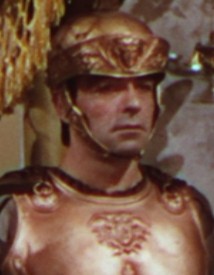 | |
| 3. |
1954 |
Siluri umani
(als Carlo Pedersoli)
|
Magrini |
|  | |
| 4. |
1955 |
Napjaink Hõse
(als Carlo Pedersoli)
|
Fernando |
|  | |
| 5. |
1957 |
Il Cocco di Mamma
(als Carlo Pedersoli)
|
Oscar |
|  | |
| 6. |
1957 |
Búcsú a fegyverektõl
(als Carlo Pedersoli)
|
Militärpolizist |
Nincs dialógusa |  | |
| 7. |
1959 |
Hannibál
(als Carlo Pedersoli)
|
Rutario |
|  | |
| 8. |
1967 |
Nincs bocsánat
|
Hutch Bessy / Dan |
Kránitz Lajos |  | |
| 9. |
1967 |
Ezer pofon ajándékba
(con)
|
O'Bannion |
Kránitz Lajos |  | |
| 10. |
1967 |
Az utolsó számlát te fizeted!
|
James Cooper |
| 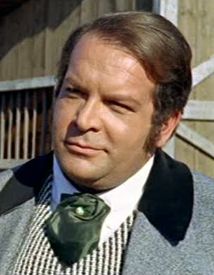 | |
| 11. |
1968 |
Bosszú El Pasóban
(con)
|
Hutch Bessy |
Vajda László |  | |
| 12. |
1969 |
Ötszemélyes hadsereg
|
Mesito |
Túri Bálint |  | |
| 13. |
1969 |
Akik csizmában halnak meg
|
Hutch Bessy
in dt. Originalfassung: Dan |
Bujtor István |  | |
| 14. |
1969 |
Vesztesek és győztesek
(e con)
|
Corporal Jelinek |
Újlaki Dénes |  | |
| 15. |
1970 |
Az ördög jobb és bal keze
|
Der Kleine / Bambino |
Bujtor István |  | |
| 16. |
1971 |
A kalózok háborúja
(e)
|
Skull |
Bujtor István |  | |
| 17. |
1971 |
Az ördög jobb és bal keze 2
|
Der Kleine / Bambino |
Bujtor István |  | |
| 18. |
1971 |
Négy légy a szürke bársonyon
(e con)
|
Diomede, Godfrey, Gottfried |
|  | |
| 19. |
1971 |
Vadnyugati Casanova
|
Hiram Coburn |
Kránitz Lajos |  | |
| 20. |
1972 |
Sötét Torino
(e con; nel ruolo di Rosario Rao)
|
Rosario Rao |
Bujtor István |  | |
| 21. |
1972 |
Élet vagy halál
|
Eli Sampson |
Bujtor István | 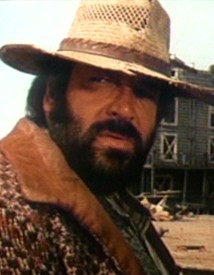 | |
| 22. |
1972 |
Mindent bele!
|
Salud |
Bujtor István |  | |
| 23. |
1972 |
Az angyalok is esznek babot
|
Charlie |
Kránitz Lajos |  | |
| 24. |
1973 |
Piedone, a zsaru
|
Kommissar Rizzo |
Bujtor István |  | |
| 25. |
1974 |
Különben dühbe jövünk
|
Ben |
Bujtor István | 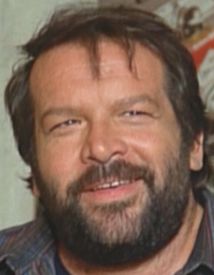 | |
| 26. |
1974 |
Morcos Misszionáriusok
|
Pater Pedro De Leon |
Bujtor István |  | |
| 27. |
1975 |
Piedone Hongkongban
|
Kommissar Rizzo |
Bujtor István |  | |
| 28. |
1975 |
A zsoldoskatona
|
Hector Fieramosca / Ettore Fieramosca da Capua |
Bujtor István |  | |
| 29. |
1977 |
Charleston
(in)
|
Charleston |
Kránitz Lajos |  | |
| 30. |
1977 |
Bûnvadászok
|
Wilbur Walsh |
Bujtor István |  | |
| 31. |
1978 |
Piedone Afrikában
|
Kommissar Rizzo |
Kránitz Lajos |  | |
| 32. |
1978 |
Akit Bulldózernek hívtak
|
Mücke |
Bujtor István |  | |
| 33. |
1978 |
És megint dühbe jövünk
|
Charlie Firpo |
Bujtor István |  | |
| 34. |
1979 |
Seriff az égbõl
|
Sheriff |
Kránitz Lajos |  | |
| 35. |
1979 |
Én a vizilovakkal vagyok
|
Tom, das Nilpferd |
Bujtor István |  | |
| 36. |
1980 |
Piedone Egyiptomban
|
Kommissar Rizzo |
Bujtor István |  | |
| 37. |
1980 |
Seriff és az idegenek
|
Sheriff |
Bujtor István |  | |
| 38. |
1981 |
Aranyesõ Yuccában
(in)
|
Bud |
Bujtor István |  | |
| 39. |
1981 |
Kincs, ami nincs
|
Charlie O Brien |
Bujtor István |  | |
| 40. |
1982 |
Banán Joe
|
Banana Joe |
Kránitz Lajos |  | |
| 41. |
1982 |
Bombajó bokszoló
|
Bud Graziano, der Bomber |
Gruber Hugó |  | |
| 42. |
1982 |
Rabló - pandúr
|
Lieutenant Alan Parker |
Kránitz Lajos |  | |
| 43. |
1983 |
Nyomás, utána!
|
Doug O'Riordan / Agent Mason |
Vajda László | 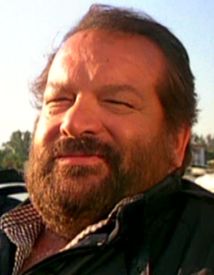 | |
| 44. |
1984 |
Nincs kettő négy nélkül
|
Antonio Coímbra / Greg Wonder |
Bujtor István |  | |
| 45. |
1985 |
Szuperhekusok
|
Steve Forrest |
Bujtor István |  | |
| 46. |
1986 |
Aladdin
|
Geist aus der Lampe |
Bujtor István |  | |
| 47. |
1988 |
Az óriási nyomozó - Egy különös biztosítás
|
Jack Clementi |
Bujtor István |  | |
| 48. |
1988 |
Az óriási nyomozó - Bumeráng
|
Jack Clementi |
Bujtor István |  | |
| 49. |
1988 |
Az óriási nyomozó - 1 uncia = 395 Dollár
|
Jack Clementi |
Bujtor István |  | |
| 50. |
1988 |
Az óriási nyomozó - A hamisítvány
|
Jack Clementi |
Bujtor István |  | |
| 51. |
1988 |
Az óriási nyomozó - A díva
|
Jack Clementi |
Bujtor István |  | |
| 52. |
1988 |
Az óriási nyomozó - Halálbiztosítás
|
Jack Clementi |
Bujtor István |  | |
| 53. |
1990 |
Fél lábbal a paradicsomban
|
Bull Webster |
Bujtor István |  | |
| 54. |
1991 |
Extralarge - Az enyveskezû
|
Jack Costello |
Kránitz Lajos |  | |
| 55. |
1991 |
Extralarge - Mozgó célpont
|
Jack Costello |
Kránitz Lajos |  | |
| 56. |
1991 |
Extralarge - A Miami ügy
|
Jack Costello |
Kránitz Lajos |  | |
| 57. |
1991 |
Extralarge - Jo-Jo
|
Jack Costello |
Kránitz Lajos |  | |
| 58. |
1991 |
Extralarge - Ágyúgolyó
|
Jack Costello |
Kránitz Lajos |  | |
| 59. |
1991 |
Extralarge - Fekete varázslat
|
Jack Costello |
Kránitz Lajos |  | |
| 60. |
1992 |
Extralarge II - A nap ura
|
Jack Costello |
Bujtor István |  | |
| 61. |
1992 |
Extralarge II - Gonzales bosszúja
|
Jack Costello |
Bujtor István |  | |
| 62. |
1992 |
Extralarge II - Gyémántok
|
Jack Costello |
Bujtor István |  | |
| 63. |
1992 |
Extralarge II - A nindzsa árnyéka
|
Jack Costello |
Bujtor István |  | |
| 64. |
1992 |
Extralarge II - Kondor küldetés
|
Jack Costello |
Bujtor István |  | |
| 65. |
1992 |
Extralarge II - Indiánok
|
Jack Costello |
Bujtor István |  | |
| 66. |
1994 |
Bunyó karácsonyig
|
Moses |
Bujtor István |  | |
| 67. |
1996 |
Őrangyalok - Balfácánok szabadlábon
|
Padre Orso / Bob Russel |
Újlaki Dénes |  | |
| 68. |
1996 |
Őrangyalok - Égbõl pottyant szerencse
|
Padre Orso / Bob Russel |
Újlaki Dénes |  | |
| 69. |
1996 |
Őrangyalok - A Mayák kincse
|
Padre Orso / Bob Russel |
Újlaki Dénes |  | |
| 70. |
1996 |
Őrangyalok - Kalandos földetérés
|
Padre Orso / Bob Russel |
Újlaki Dénes |  | |
| 71. |
1996 |
Őrangyalok - Dolláreső
|
Padre Orso / Bob Russel |
Újlaki Dénes |  | |
| 72. |
1996 |
Őrangyalok - Aranyláz
|
Padre Orso / Bob Russel |
Újlaki Dénes |  | |
| 73. |
1997 |
Fuochi d'artificio
(il cieco è)
|
Gandhi, der blinde Sänger |
|  | |
| 74. |
1997 |
A végsõ határ
|
Elorza |
Papp János | 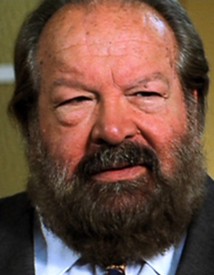 | |
| 75. |
1997 |
Hárman az örökkévalóságnak
|
Bops |
Újlaki Dénes | 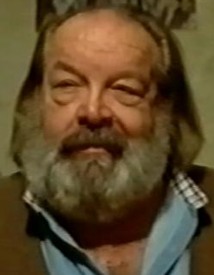 | |
| 76. |
1999 |
A szél fiai
|
Quintero |
Kránitz Lajos | 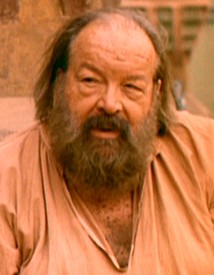 | |
| 77. |
2001 |
Atyai pofonosztó
(in)
|
Don Carlo Vasari |
Kránitz Lajos | 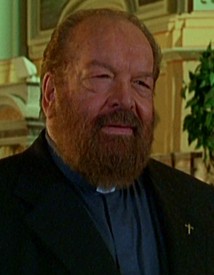 | |
| 78. |
2003 |
Dal a bordélyházból
|
Der alte Kapitän, Erzähler |
Újlaki Dénes |  | |
| 79. |
2008 |
Pane e olio
(con la partecipazione straordinaria di)
|
Laris |
|  | |
| 80. |
2008 |
Maffiózó vagyok, drágám!
|
Pepe |
Papp János |  | |
| 81. |
2010 |
Nincs kettő séf nélkül - A hal szeme 2/2
|
Carlo Banci |
Papp János |  | |
| 82. |
2010 |
Nincs kettő séf nélkül - A kis szemtanú (3. rész)
|
Carlo Banci |
Papp János |  | |
| 83. |
2010 |
Nincs kettő séf nélkül - Bűntény a szállóban (4. rész)
|
Carlo Banci |
Papp János |  | |
| 84. |
2010 |
Nincs kettő séf nélkül - Nők hálójában (5. rész)
|
Carlo Banci |
Papp János |  | |
| 85. |
2010 |
Nincs kettő séf nélkül - Partnercsere (6. rész)
|
Carlo Banci |
Papp János |  | |
| 86. |
2010 |
Nincs kettő séf nélkül - Sulibuli (7. rész)
|
Carlo Banci |
Papp János |  | |
| 87. |
2010 |
Nincs kettő séf nélkül - Halál tánclépésben (8. rész)
|
Carlo Banci |
Papp János |  | |
| 88. |
2010 |
Nincs kettő séf nélkül - Ki ölte meg a séfet? (9. rész)
|
Carlo Banci |
Papp János |  | |
| 89. |
2010 |
Nincs kettő séf nélkül - A rajongó halála (10. rész)
|
Carlo Banci |
Papp János |  | |
| 90. |
2010 |
Nincs kettő séf nélkül - Nyomtalanul (11. rész)
|
Carlo Banci |
Papp János |  | |
| 91. |
2010 |
Nincs kettő séf nélkül - A királynő kincse (12. és befejező rész)
|
Carlo Banci |
Papp János | 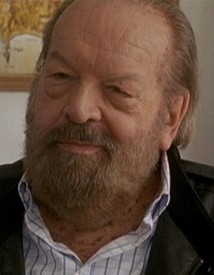 | |
|
| Fel |
 |
| Mint stábtag |
| |
| Szerző |
| No. |
év |
Title |
Kiadó |
Ország |
 |
| 1 |
2018 |
Bud Spencer - Mi chiamavano Bud |
Volume |
Italien |
| 2 |
2014 |
Bud Spencer, Lorenzo De Luca - 80 év alatt a föld körül |
Libri Kiadó |
Ungarn |
| 3 |
2015 |
Bud Spencer, Lorenzo De Luca - Eszem, tehát vagyok |
Libri Kiadó |
Ungarn |
| 4 |
2014 |
Bud Spencer, Lorenzo De Luca - Ich esse, also bin ich - Mangio ergo sum - Meine Philosophie des Essens |
Schwarzkopf & Schwarzkopf |
Deutschland |
| 5 |
2018 |
Bud Spencer, Lorenzo De Luca - Ich esse, also bin ich - Mangio ergo sum - Meine Philosophie des Essens (Taschenbuch) |
Schwarzkopf & Schwarzkopf |
Deutschland |
| 6 |
2022 |
Bud Spencer, Lorenzo De Luca - Il giro del mondo in ottant'anni - L'autobiografia di Bud Spencer |
Burno |
Italien |
| 7 |
2012 |
Bud Spencer, Lorenzo De Luca - In achtzig Jahren um die Welt - Der zweite Teil meiner Autobiografie |
Schwarzkopf & Schwarzkopf |
Deutschland |
| 8 |
2018 |
Bud Spencer, Lorenzo De Luca - In achtzig Jahren um die Welt - Der zweite Teil meiner Autobiografie (Taschenbuch) |
Schwarzkopf & Schwarzkopf |
Deutschland |
| 9 |
2014 |
Bud Spencer, Lorenzo De Luca - Mangio ergo sum |
Nicola Pesce Editore |
Italien |
| 10 |
2011 |
Bud Spencer, Lorenzo De Luca - Mein Leben, Meine Filme - Die Autobiografie |
Schwarzkopf & Schwarzkopf |
Deutschland |
| 11 |
2011 |
Bud Spencer, Lorenzo De Luca - Mein Leben, meine Filme - Die Autobiografie (Hörbuch) |
Schwarzkopf & Schwarzkopf |
Deutschland |
| 12 |
2018 |
Bud Spencer, Lorenzo De Luca - Mein Leben, Meine Filme - Die Autobiografie (Taschenbuch) |
Schwarzkopf & Schwarzkopf |
Deutschland |
| 13 |
2024 |
Bud Spencer, Lorenzo De Luca - Mes mille et une vies |
L'éditeur à part |
Frankreich |
| 14 |
2025 |
Bud Spencer, Lorenzo De Luca - Nickname Bud Spencer. Dal set al computer, Bud Spencer dentro al mondo digitale |
Burno |
Italien |
| 15 |
2016 |
Bud Spencer, Lorenzo De Luca - Was ich euch noch sagen wollte... |
Schwarzkopf & Schwarzkopf |
Deutschland |
| 16 |
2016 |
Bud Spencer, Lorenzo De Luca - Was ich euch noch sagen wollte... (Limitierte Sonderausgabe) |
Schwarzkopf & Schwarzkopf |
Deutschland |
| 17 |
2018 |
Bud Spencer, Lorenzo De Luca - Was ich euch noch sagen wollte... (Taschenbuch) |
Schwarzkopf & Schwarzkopf |
Deutschland |
| 18 |
2010 |
Bud Spencer, Lorenzo De Luca, David De Filippi - Altrimenti mi arrabbio - La mia vita |
Aliberti editore |
Italien |
| 19 |
2025 |
Bud Spencer, Lorenzo De Luca, David De Filippi - Altrimenti mi arrabbio - Silenzio, parla Bud Spencer |
Burno |
Italien |
| 20 |
2013 |
Bud Spencer, Lorenzo De Luca, David De Filippi - Különben dühbe jövök |
Libri Kiadó |
Ungarn |
| 21 |
2014 |
Bud Spencer, Lorenzo De Luca, David De Filippi - Különben dühbe jövök |
Libri Kiadó |
Ungarn |
| 22 |
2010 |
Bud Spencer, Lorenzo De Luca, David De Filippi - Különben dühbe jövök - Önéletrájz |
Nyitott Könyvmühely |
Ungarn |
|
| Fel |
|
| Fel |
 |
| TV-Shows |
| |
|
|
 |
| A színész adatlapját ennyien nézték eddig: 317814. |
|
